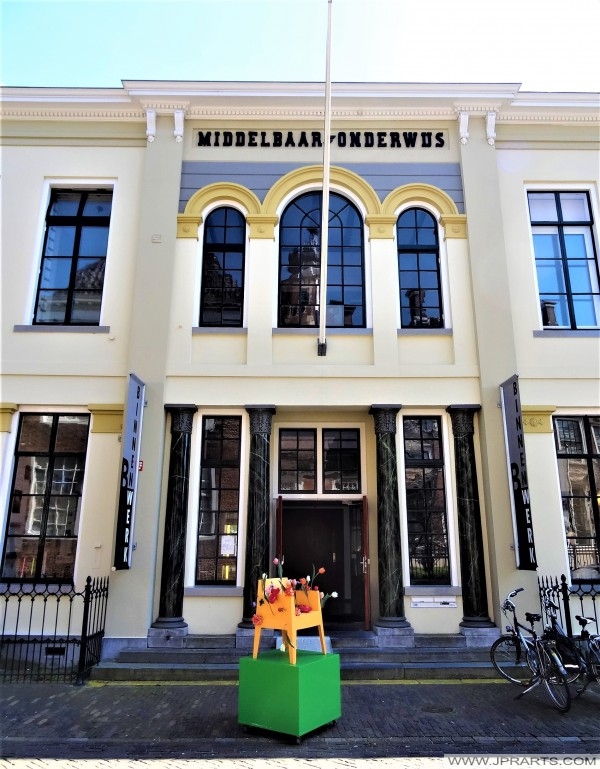Groningen (Gronings: Grunn or Grunnen) is the capital city and main municipality of Groningen province in the Netherlands. It is the largest city in the north of the Netherlands. As of December 2021, it had 235,287 inhabitants. It has a land area of 168.93 km2 (65.22 sq mi), and a total area, including water, of 180.21 km2 (69.58 sq mi). On 1 January 2019, it was merged with the municipalities of Ten Boer and Haren. Groningen is a university city, and students comprise an estimated 25% of its total population. Historically, it was a semi-independent city-state, a member of the Hanseatic League, and the dominant regional power in the north of the Netherlands.
Groningen, The Netherlands
Groninga, Países Bajos
The origin and meaning of ‘Groningen’ and its older variant, ‘Groeningen’, are uncertain. A folk origin story relates the idea that, in 453 BC, exiles from Troy who were guided by a mythical figure called Gruno (or Grunius, Gryns or Grunus), along with a group of Phrygians from Germany, founded a settlement in what is now Groningen, and built a castle on the bank of the Hunze, which they called ‘Grunoburg’, and which was later destroyed by the Vikings.
One modern theory is that ‘Groningen’ meant ‘among the people of Groni’ (‘Groningi’ and ‘Groninga’ in the 11th century), derived from Gronesbeke, which was the old name for a small lake near the Hunze (on the northern border of Zuidlaarderveen). Another theory is that the name was derived from the word groenighe, meaning ‘green fields’.
During the French occupation of the area, Groningen was called Groningue. In Frisian, it is called Grins. In Groningen province, it is called Groot Loug. Regionally, it is often simply referred to as Stad (the “city”), and its inhabitants are referred to as Stadjers or Stadjeder. The Dutch sometimes refer to it as “the Metropolis of the North”, or Martinistad (after the Martinitoren tower.)
Groningen, Niederlande
荷兰格罗宁根
The city was founded at the northernmost point of the Hondsrug area. While the oldest document referring to Groningen’s existence dates from 1040, the city was occupied by Anglo-Saxons centuries prior. The oldest archaeological evidence of a civilization in the region stem from around 3950–3650 BC, and the first major settlement in Groningen trace back to the year 3 AD.
In the 13th century Groningen was an important trade centre and its inhabitants built a city wall to underline its authority. The city had a strong influence on its surrounding lands and the Gronings dialect became a common tongue. The most influential period of the city was at the end of the 15th century, when the nearby province of Friesland was administered from Groningen. During these years the Martinitoren was built which is considered to be the city’s most significant landmark.
جرونينجن ، هولندا
Groningue, Pays-Bas
In 1536, Groningen accepted Emperor Charles V, the King of Spain and the Habsburg ruler of the other Netherlands as its ruler, thus ending the region’s autonomy. The city was captured in the Siege of Groningen (1594) by the Dutch and English forces led by Maurice of Nassau. After the siege, the city and the province joined the Dutch Republic.
The University of Groningen was founded in 1614 with initial course offerings in law, medicine, theology and philosophy. During the same period the city expanded rapidly and a new city wall was built. The Siege of Groningen (1672) led by the bishop of Münster, Bernhard von Galen during the Third Anglo-Dutch War failed and the city walls resisted; an event that is celebrated annually with music and fireworks on 28 August as “Gronings Ontzet” or “Bommen Berend“.
During World War II, the main square and the Grote Markt were largely destroyed in the Battle of Groningen in April 1945. However, the church Martinitoren, the Goudkantoor, and the city hall were undamaged.
Groningen, Nederland
Гронинген, Нидерланды
Hotel and catering industries constitute a significant part of the economy in Groningen. Focus on business services has increased over time and areas such as IT, life sciences, tourism, energy, and environment have developed.
Until 2008 there were two major sugar refineries within the city. The Suiker Unie plant was constructed in the outskirts of Groningen, but became a part of the city due to expansion. The factory had 98 employees before it was shutdown in 2008 due to a reduction in demand. As of 2017, CSM Vierverlaten in Hoogkerk remains the only beet sugar production plant in the city. Other notable companies from Groningen include publishing company Noordhoff Uitgevers, tobacco company Royal Theodorus Niemeyer, health insurance company Menzis, distillery Hooghoudt, and natural gas companies GasUnie and GasTerra.
Groningen, Belanda
네덜란드 흐로닝언
Visit Netherlands Travel to Book Flights and Hotels Easy Online
Visit the Cheap Webshop for Blu-rays, Books and DVDs




